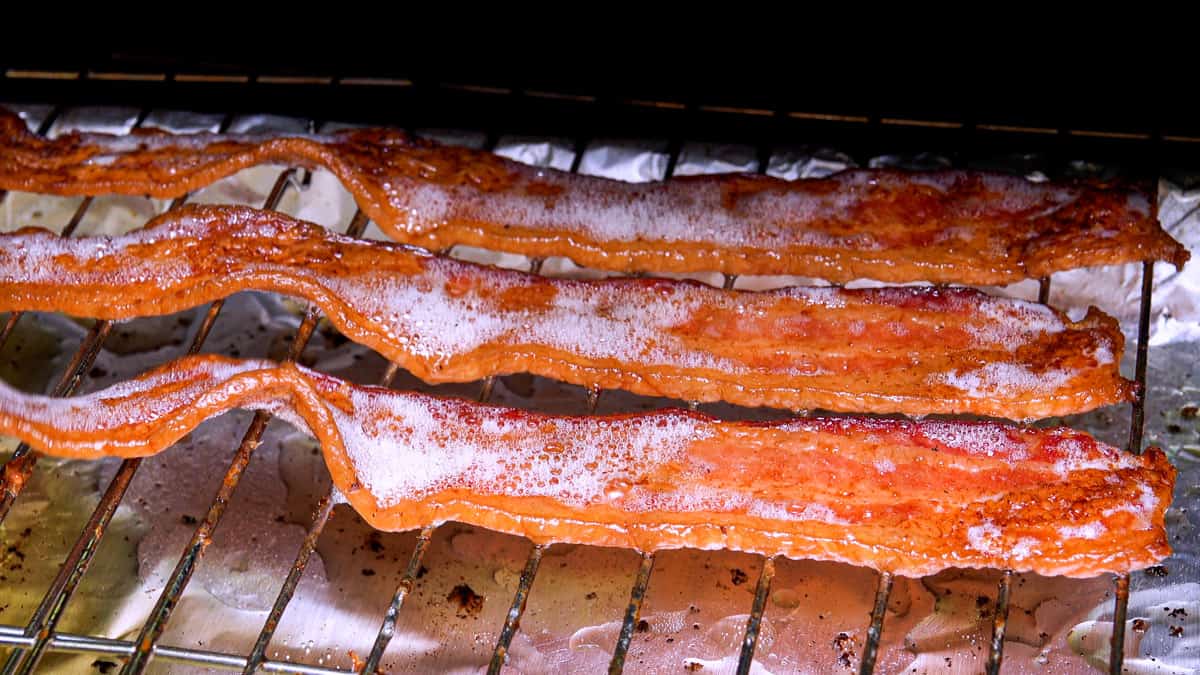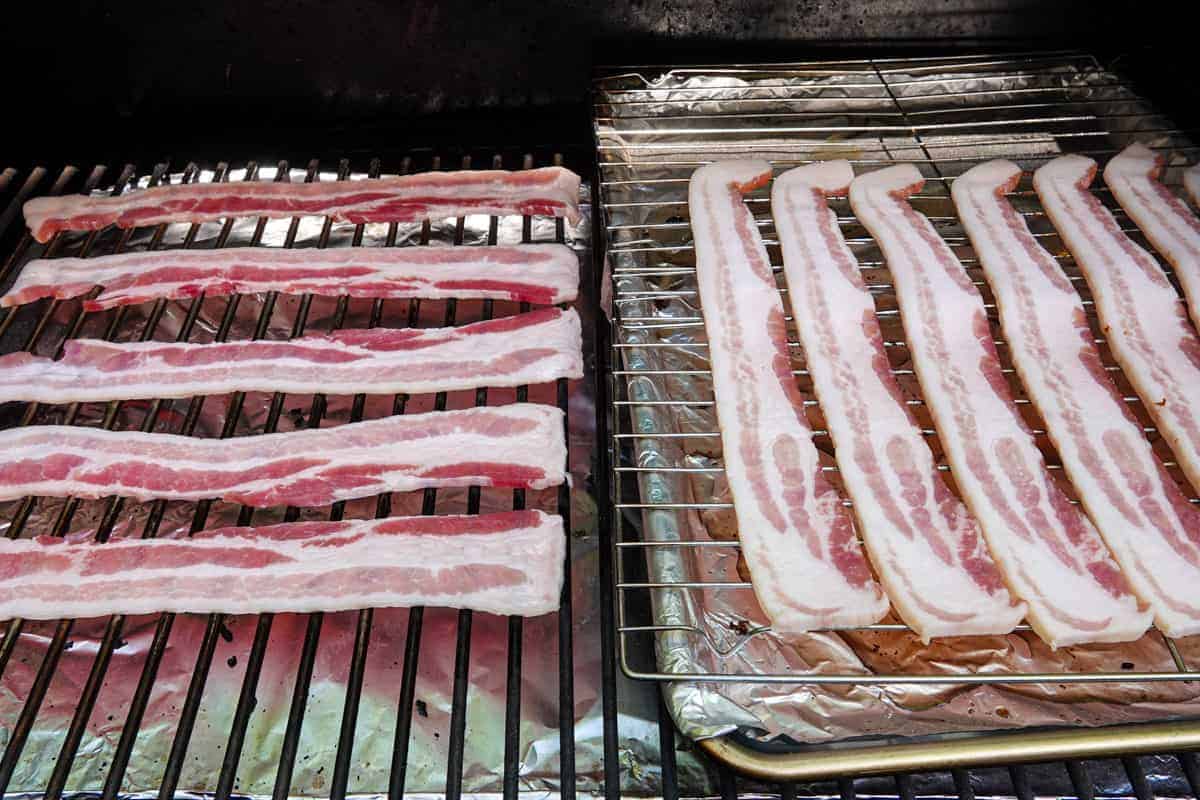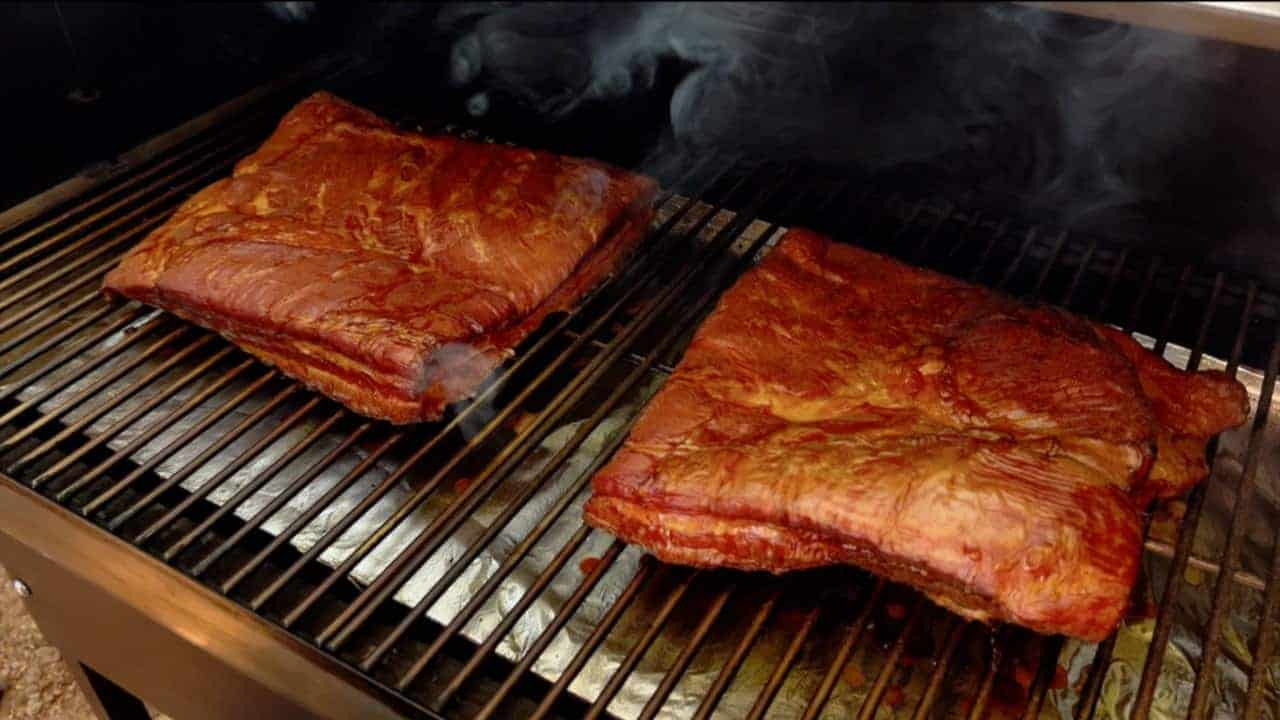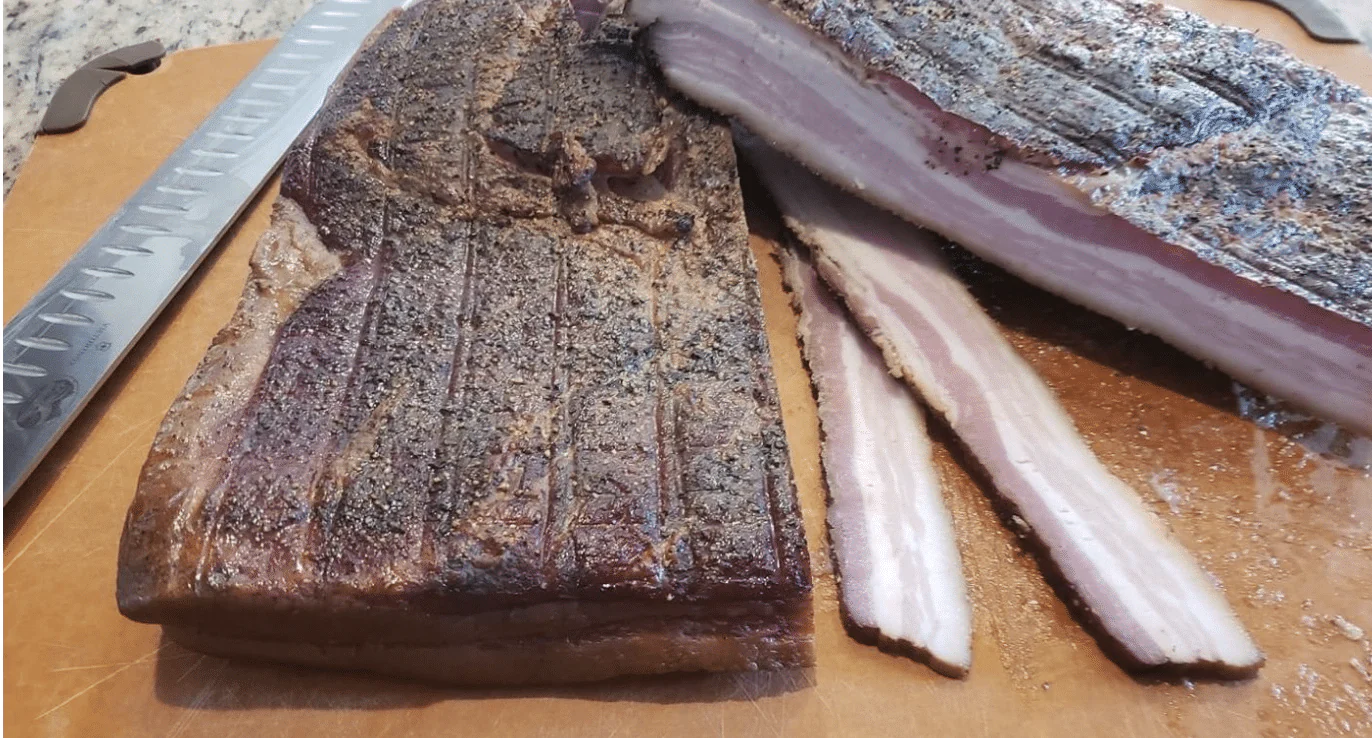To smoke bacon in a smoker, cure the pork belly, rinse and dry it, then smoke it at a low temperature (around 175°F) until it reaches an internal temperature of 150°F.
Bacon Bliss: Unlocking the Secrets to Smoking the Perfect Strip
Bacon has been a beloved food for centuries, with its origins dating back to ancient times. The process of curing and smoking pork belly to create bacon has been practiced by various cultures throughout history.
In modern times, bacon has become even more popular, with its crispy texture and savory flavor making it a staple in many households. People love bacon for its versatility, as it can be enjoyed on its own, added to sandwiches and salads, or used as a flavorful ingredient in various dishes.
The Science of Smoking: Understanding the Basics
Smoking is a cooking technique that involves exposing food to smoke from burning or smoldering wood. This process not only imparts a distinct smoky flavor to the food but also helps to preserve it. When it comes to bacon, smoking plays a crucial role in enhancing its flavor and texture. The smoke penetrates the meat, infusing it with a rich, smoky taste that is highly sought after by bacon enthusiasts.
During the smoking process, several chemical reactions occur that contribute to the unique flavor of smoked bacon. One of these reactions is the Maillard reaction, which is responsible for the browning and caramelization of the meat’s surface. This reaction creates complex flavors and aromas that are characteristic of smoked bacon. Additionally, the smoke contains compounds called phenols, which give bacon its distinct smoky taste.
Choosing the Right Cut: Which Strip is Best for Smoking?
When it comes to choosing the right cut of bacon for smoking, there are several options to consider. The most common cuts of bacon include slab bacon, which is a thick piece of pork belly with the skin still attached, and sliced bacon, which is thinly sliced pork belly without the skin.
For smoking purposes, slab bacon is often preferred as it allows for more control over the smoking process. The thickness of slab bacon allows it to absorb more smoke and develop a deeper flavor. Additionally, the skin on slab bacon helps to retain moisture during the smoking process, resulting in a juicier end product.
When choosing a cut of bacon for smoking, it is important to consider factors such as the fat content and marbling. A higher fat content and marbling will result in a more flavorful and tender bacon. However, it is also important to strike a balance, as too much fat can lead to greasy bacon.
Prepping the Meat: Tips for Brining and Seasoning
Brining is an essential step in preparing bacon for smoking. Brining involves soaking the meat in a solution of salt, sugar, and water, which helps to enhance its flavor and moisture content. The salt in the brine helps to break down proteins in the meat, resulting in a more tender and juicy end product.
To brine bacon, start by dissolving salt and sugar in water to create a brine solution. Place the bacon in a container or resealable bag and pour the brine over it, ensuring that the meat is fully submerged. Refrigerate the bacon for at least 24 hours, but no more than 48 hours, to allow the flavors to penetrate the meat.
In addition to brining, seasoning can also be added to enhance the flavor of smoked bacon. Common seasonings for bacon include black pepper, garlic powder, paprika, and brown sugar. These seasonings can be applied directly to the meat before smoking or added to the brine solution for a more even distribution of flavors.
Setting Up Your Smoker: Equipment and Temperature Control
When it comes to smoking bacon, there are several types of smokers to choose from. The most common types include charcoal smokers, electric smokers, and pellet smokers. Each type has its own advantages and disadvantages, so it is important to choose one that suits your needs and preferences.
Once you have chosen a smoker, it is important to properly set it up for smoking bacon. Start by filling the smoker’s water pan with water, as this will help to regulate the temperature and keep the meat moist during the smoking process. Next, add wood chips or chunks to the smoker’s firebox or tray. The type of wood you choose will have a significant impact on the flavor of your smoked bacon, so it is important to choose wisely.
Temperature control is crucial when smoking bacon, as it affects both the flavor and texture of the meat. The ideal smoking temperature for bacon is around 200-225 degrees Fahrenheit. It is important to monitor the temperature throughout the smoking process and make adjustments as needed to maintain a consistent temperature.
The Art of Smoking: Techniques for Achieving the Perfect Flavor
There are several techniques that can be used to achieve the perfect flavor when smoking bacon. One popular technique is cold smoking, which involves smoking the bacon at a low temperature for an extended period of time. This technique allows the smoke to slowly penetrate the meat, resulting in a more pronounced smoky flavor.
Another technique is hot smoking, which involves smoking the bacon at a higher temperature for a shorter period of time. This technique produces a smoky flavor that is less intense but still delicious. Hot smoking also helps to cook the bacon, resulting in a crispy texture.
To achieve an even flavor when smoking bacon, it is important to rotate and flip the meat periodically during the smoking process. This ensures that all sides of the bacon are exposed to the smoke and develop an even smoky flavor.
The Importance of Wood: Types and Pairings for Bacon
The type of wood you choose for smoking bacon can greatly impact its flavor. Different types of wood impart different flavors, so it is important to choose one that complements the natural flavors of bacon.
Some popular types of wood for smoking bacon include hickory, applewood, and maple. Hickory is known for its strong and smoky flavor, which pairs well with the rich and savory taste of bacon. Applewood provides a slightly sweet and fruity flavor that adds a unique twist to smoked bacon. Maple wood offers a subtle sweetness that enhances the natural flavors of bacon.
When choosing the right wood for your bacon, it is important to consider the intensity of the wood’s flavor. Stronger woods like hickory and mesquite are best suited for bold and savory flavors, while milder woods like applewood and cherrywood are better suited for delicate and sweet flavors.
Timing is Everything: How Long to Smoke Your Bacon
The length of time it takes to smoke bacon can vary depending on several factors, including the thickness of the meat, the temperature of the smoker, and personal preference. As a general guideline, it is recommended to smoke bacon for 2-4 hours.
It is important to note that smoking bacon for too long can result in an overly smoky flavor and a dry texture. On the other hand, smoking bacon for too short a time may result in a milder smoky flavor. It is important to find the right balance and adjust the smoking time accordingly.
To determine if your bacon is done smoking, you can use a meat thermometer to check the internal temperature. The ideal internal temperature for smoked bacon is around 150 degrees Fahrenheit. Once the bacon reaches this temperature, it is ready to be removed from the smoker.
The Finishing Touches: Resting and Slicing Your Bacon
After smoking your bacon, it is important to allow it to rest before slicing and serving. Resting allows the juices in the meat to redistribute, resulting in a more tender and flavorful end product.
To rest your bacon, remove it from the smoker and let it sit at room temperature for about 10-15 minutes. This will allow the meat to cool slightly and the flavors to develop further. Once the bacon has rested, it can be sliced to your desired thickness and served.
When slicing bacon, it is important to use a sharp knife and make clean, even cuts. This will ensure that each slice is uniform in thickness and easy to cook. Thinly sliced bacon is ideal for crispy bacon strips, while thicker slices are better suited for dishes that require a more substantial bacon presence.
Creative Serving Ideas: Beyond Breakfast and BLTs
While bacon is often associated with breakfast and BLTs, there are many creative ways to incorporate it into different dishes. Bacon can add a smoky and savory flavor to a wide range of recipes, from appetizers to main courses and even desserts.
One popular way to enjoy smoked bacon is by adding it to salads. Crumbled bacon can add a crunchy texture and a burst of flavor to a simple green salad. Bacon-wrapped appetizers are also a crowd-pleaser, with options like bacon-wrapped dates or bacon-wrapped jalapeno poppers.
In main courses, bacon can be used as a flavor enhancer in dishes like pasta carbonara or bacon-wrapped chicken. It can also be used as a topping for burgers or added to soups and stews for an extra layer of richness.
For those with a sweet tooth, bacon can even be incorporated into desserts. Chocolate-covered bacon or maple-bacon cupcakes are just a few examples of how bacon can add a unique twist to sweet treats.
Troubleshooting Tips: Common Problems and How to Fix Them
While smoking bacon can be a rewarding experience, it is not without its challenges. Here are some common problems that may arise when smoking bacon and how to fix them:
1. Greasy Bacon: If your bacon turns out greasy, it may be due to excessive fat content or insufficient smoking time. To fix this, try trimming off excess fat before smoking and increase the smoking time to allow the fat to render out.
2. Bitter Flavor: A bitter flavor in smoked bacon can be caused by excessive smoke or the use of certain types of wood. To fix this, reduce the amount of smoke by using fewer wood chips or switch to a milder wood variety.
3. Dry Texture: If your bacon turns out dry, it may be due to overcooking or insufficient brining. To fix this, reduce the smoking time and make sure to brine the bacon for an adequate amount of time to retain moisture.
4. Uneven Smoking: Uneven smoking can occur if the bacon is not properly rotated or if there are temperature fluctuations in the smoker. To fix this, make sure to rotate the bacon periodically during smoking and monitor the temperature closely.
Conclusion:
Smoking bacon is a culinary art that requires patience, attention to detail, and a love for smoky flavors. By understanding the basics of smoking, choosing the right cut of bacon, and mastering the techniques involved, you can achieve the perfect balance of smoky flavor and tender texture in your homemade bacon.
With a wide range of serving ideas and creative recipes, smoked bacon can elevate any dish and add a unique twist to your culinary creations. So why not give it a try at home and experience the joy of smoking bacon for yourself?
Originally posted 2024-02-07 01:50:10.




